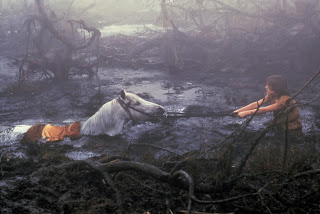You have probably had a few sandcastle building competitions
with friends or siblings growing up and have a good idea about how to build the
best castle. Most people realise early on that closer to the shore, where the
sand is wet, is where you can build the biggest and most impressive
castles. However, can too much water
make your castle more of a flop than a fort?
Probably more
impressive than your average sandcastle. (https://commons.wikimedia.org/wiki/File:Sandcastle_sculpture_(4856466479).jpg,
accessed 2/6/2020)
The reason dry grains can be built up into a slope is mainly
due to the friction between the grains and the overlying weight of other
grains, pushing them down. When a little water is added, this can increase the
cohesion of the grains as surface tension helps hold them together more
strongly.
- To read more about slope stability of different materials read slope stability (I) and watch the corresponding video.
- To learn more about cohesion and surface tension of water
read breaking bonds
Too much water has caused instability, leading to a landslide (https://commons.wikimedia.org/wiki/File:Landslide_in_Cusco,_Peru_-_2018.jpg, accessed 2/6/2020)
When more water is added to the mix it greatly increases the
weight of the sand. This means that there is more gravitational force pulling
it downwards. The most significant effect of adding more water is that it can
saturate the sand. Water will surround all grains and eliminates grain to grain
contact. In this instance, the water acts as a lubricant, and turns the mix
into a slurry, which flows like a fluid. This can cause natural hazards such as
landslides, lahars, quicksand, and liquefaction. To find out the effect of adding water to sand on slope stability watch this video.
- To learn more about these natural hazards read: Lahars and Liquefaction
- To read more about quicksand read this article: How deadly is quicksand?
Quicksand was one
of the most popular ways to kill a hero in a 1980s movie. This scene from The
Neverending Story was probably the one that scared most children.. https://www.pinterest.com.au/pin/520588038157887208/,
accessed 2/6/2020)
It is not only unconsolidated slopes of sand or soils that
are affected by addition of water. Heavy rainfall or snowmelt can also lead to the soluble minerals which cement rocks together dissolving, such as halite and
calcite. This can be dangerous and could lead to sinkhole formation. Sinkholes
have been known to swallow up whole houses. However, this process is also what
leads to beautiful and impressive cave formation, like those found in the
Margret River region of Western Australia.
Caves can be
beautiful as well as exciting (https://www.bgs.ac.uk/mendips/caveskarst/caveform.htm#:~:text=Caves%20are%20formed%20by%20the,enlarged%20enough%20to%20form%20caves.,
accessed 2/6/2020)
There are numerous ways to avoid these natural hazards from
occurring. The main focus is upon ensuring the land does not become saturated.
Installing appropriate drainage to allow the flow of water is one method.
Adding vegetation (particularly trees), can be very effective as not only do they
absorb a lot of the water, but their roots also help to hold the soil
together.
- To experiment with the effect of vegetation on preventing erosion have a go at this experiment: Preventing Soil Erosion
- For more information on cave formation read this article from the British Geological Society: How caves form
- For more detail on slope stability and some case studies read these lecture notes from Tulane University: Slope Stability, Triggering Events, Mass Movement Hazards





